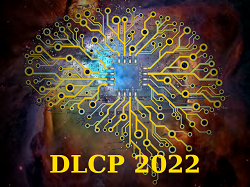
JINR, Dubna, Russia
published December 06, 2022
The Workshop will be held in the Meshcheryakov Laboratory of Information Technologies (MLIT) of the Joint Institute for Nuclear Research (JINR) on July 6-8, 2022.
The workshop primarily focuses on the use of machine learning in particle astrophysics and high energy physics, but is not limited to this area. Topics of interest are various applications of artificial neural networks to physical problems, as well as the development of new modern machine learning methods for analyzing various scientific data, including big data.
The workshop website: https://dlcp2022.jinr.ru/.
Organizers
* Joint Institute for Nuclear Research, Meshcheryakov Laboratory of Information Technologies (MLIT JINR, Dubna, Russia)
* M.V. Lomonosov Moscow State University, D.V. Skobeltsyn Institute of Nuclear Physics (SINP MSU, Moscow, Russia).
Track 1. Machine Learning in Particle Astrophysics and High Energy Physics
* Machine learning methods in particle astrophysics and high energy physics.
* Fast event generators based on machine learning for modelling of physics
phenomena.
* Multi-messenger data analysis of experimental data.
* Application machine learning for data analysis in LHC, NICA, TAIGA and
other experimental facilities.
Track 2. Modern Machine Learning Methods
* Convolutional neural networks.
* Recurrent neural networks.
* Graph neural networks.
* Modern trends in machine learning.
Track 3. Machine Learning in Natural Sciences
* Biology and bioinformatics.
* Engineering sciences.
* Climate prediction and Earth monitoring.
Track 4. Machine Learning in Education
* Machine learning in High education.
* Outreach knowledge in machine learning.

| Preface |
|---|
|
Preface
|
| Track1. Machine Learning in Particle Astrophysics and High Energy Physics |
|
A machine learning approach to identify the air shower cores for the GRAPES-3 experiment
|
|
Energy reconstruction in analysis of Cherenkov telescopes images in TAIGA experiment using deep learning methods
|
|
Using conditional variational autoencoders to generate images from atmospheric Cherenkov telescopes
|
|
Using a Conditional Generative Adversarial Network to Control the Statistical Characteristics of Generated Images for IACT Data Analysis
|
|
Deep neural network applications for particle tracking at the BM@N and SPD experiments
|
|
Application of convolutional neural networks for data analysis in TAIGA-HiSCORE experiment
|
| Track2. Modern Machine Learning Methods |
|
Decomposition of Spectral Contour into Gaussian Bands using Gender Genetic Algorithm
|
|
A spiking neural network with fixed synaptic weights based on logistic maps for a classification task
|
|
Stochastic vs. BFGS Training in Neural Discrimination of RF-Modulation
|
|
Self-organized intelligent quantum controller: quantum deep learning and quantum genetic algorithm – QSCOptKBTM toolkit
|
|
Deep learning approach to high dimensional problems of quantum mechanics
|
|
Relation Extraction from Texts Containing Pharmacologically Significant Information on base of Multilingual Language Models
|
| Track3. Machine Learning in Natural Sciences |
|
Short-length peptides contact map prediction using Convolution Neural Networks
|
|
Application of a neural network approach to the task of arena marking for the ”Open Field” behavioral test
|
|
Neural network recovery of missing data of one geophysical method from known data of another one in solving inverse problems of exploration geophysics
|
|
Hazy images dataset with localized light sources for experimental evaluation of dehazing methods
|
|
Visual clustering of marine sediment particles using a combination of unsupervised machine learning methods
|
|
Google Earth Engine and machine learning for Earth monitoring
|
|
Data-driven approximation of downward solar radiation flux based on all-sky optical imagery using machine learning models trained on DASIO dataset
|
|
Approximation of high-resolution surface wind speed in the North Atlantic using discriminative and generative neural models based on RAS-NAAD 40-year hindcast
|
|
Underwater biotope mapping: automatic processing of underwater video data
|
|
Accuracy of COVID-19 evolution models for different forecast horizons
|
|
Taking into Account Mutual Correlations during Selection of Significant Input Features in Neural Network Solution of Inverse Problems of Spectroscopy
|
| Track4. Machine Learning in Education |
|
ML/DL/HPC Ecosystem of the HybriLIT Heterogeneous Platform (MLIT JINR): New Opportunities for Applied Research
|
|
Methods and algorithms of the analytical platform for analyzing the labor market and the compliance of the higher education system with market needs
|
| Posters |
|
Neuromorphic improvement of the Weizsäecker formula
|
|
NARX neural prediction of oscillationalinstability at the IBR-2M reactor
|
